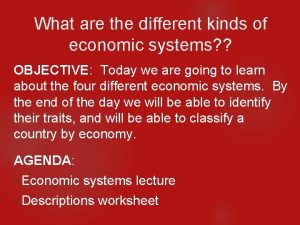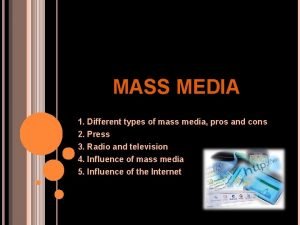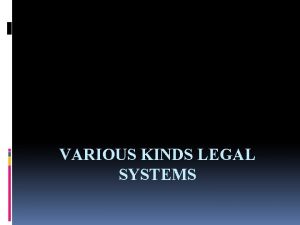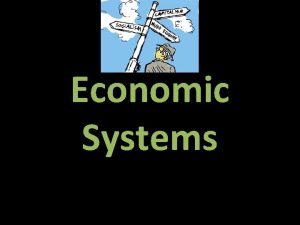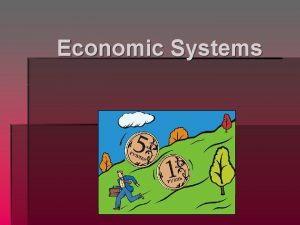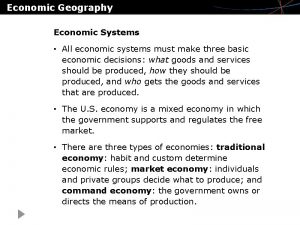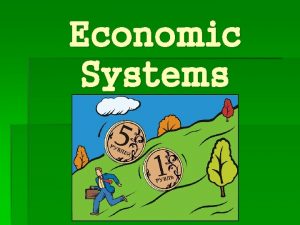What are the different kinds of economic systems















- Slides: 15

What are the different kinds of economic systems? ? OBJECTIVE: Today we are going to learn about the four different economic systems. By the end of the day we will be able to identify their traits, and will be able to classify a country by economy. AGENDA: § Economic systems lecture § Descriptions worksheet

What is the relationship? COMMAND TRADITIONAL MARKET MIXED

Economic systems § The way a society organizes to produce, distribute, and consume goods. § Economic systems try to prevent surpluses (having too much of a good or service) § Economic systems try to avoid shortages (having too little of a good or a service) § The four types of economic systems are: traditional, market, command, and mixed.

Traditional economy § An economic system where tradition and custom govern economic decisions § Economic activities are usually centered toward the family, tribe, or ethnic group § Resources are allocated based on inheritance § Farming, hunting, and gathering are done largely in the same fashion as the generation before § Choices are determined by environment § Little or no use of technology

Pros & Cons of traditional economy + Little friction among members because there is little competition + Individual roles are clearly defined + System is generally well understood by participants - Does not allow for growth and development - Changes are slow - There is little social mobility (your role is determined by birth) - Does not take advantage of technology

Examples of traditional economies The Inuit of Nunavut, Canada The Batwa of the Bwindi Impenetrable Forest, Uganda The Kayapo of the Amazon in

Command economy § The government or other central authority makes all economic decisions, including the price of goods and services § Resources are owned by the government § There is no competition; the purpose of business is to provide goods and services, not to make a profit § Factories are concerned with quotas § Consumers have few, if any, choices in the market place

Pros & cons of a command economy + Can ensure stability because it does not coincide with business cycles + Serves people collectively instead of individuals; focus on equality + Distributes wealth among all of society + Products produces fulfill needs -Often there is insufficient resource distribution (shortage/surplus) -Lack of incentives for innovation -Infringes on personal freedoms -Can often lead to corruption among state planners

Examples of command economies

Market economy § Economic decisions are made by individuals competing to earn profits § Based on supply and demand § Resources are owned by individuals § Profit, not quota, is the motive for increasing work § Competition determines price and increases the quality of products § Individuals have freedom to make economic decisions

Pros & cons of a market economy + Prices determined by supply and demand competition brings down prices + Consumers can buy whatever they like in whatever amounts they want + No government intervention + Great variety of goods and services -Does not provide basic needs of everyone in society, which can lead people to slip into poverty -Makes it difficult for government to provide adequate social services -There are occasionally market failures

Examples of market economies

Mixed economies § Combines elements of pure market and command economies; government and individuals share the economic decision making process § Government guides and regulates production of goods and services § Resources are owned by individuals § Government serves to protect both producers and consumers from unfair

Pros & Cons of mixed economies Mixed economies have all the advantages and disadvantages of command market economies and + Can focus on social welfare and political freedom, as well as individual liberties -May not lead to optimal use of resources

Examples of mixed economies
 What are the different kinds of economic systems
What are the different kinds of economic systems Antigentest åre
Antigentest åre Chapter 1 lesson 2 our economic choices worksheet answers
Chapter 1 lesson 2 our economic choices worksheet answers 8 kinds of love
8 kinds of love Claim of value examples
Claim of value examples Different kinds of laxatives
Different kinds of laxatives Steaks market form
Steaks market form These are many kinds of sport
These are many kinds of sport Kind of shop
Kind of shop Comparison and contrast pattern of text development
Comparison and contrast pattern of text development Patterns of development comparison and contrast
Patterns of development comparison and contrast Types of mass media
Types of mass media Different kinds of lines
Different kinds of lines Kinds of greetings
Kinds of greetings 4 different types of printmaking
4 different types of printmaking Different kinds of quantitative research
Different kinds of quantitative research
